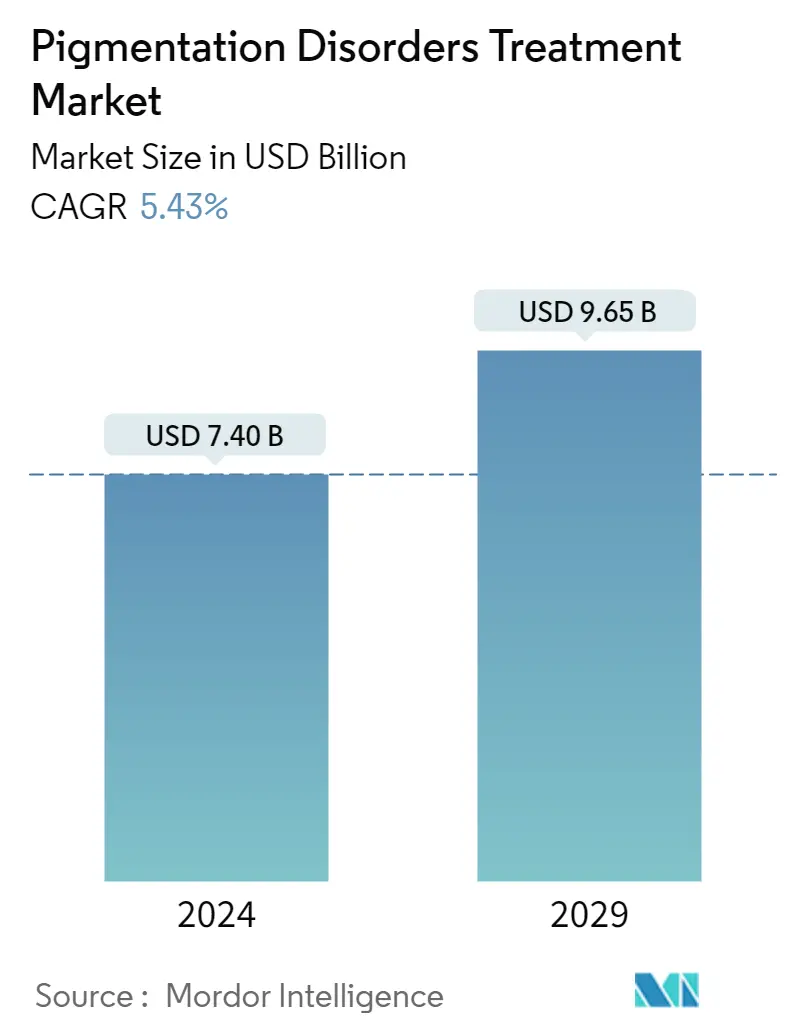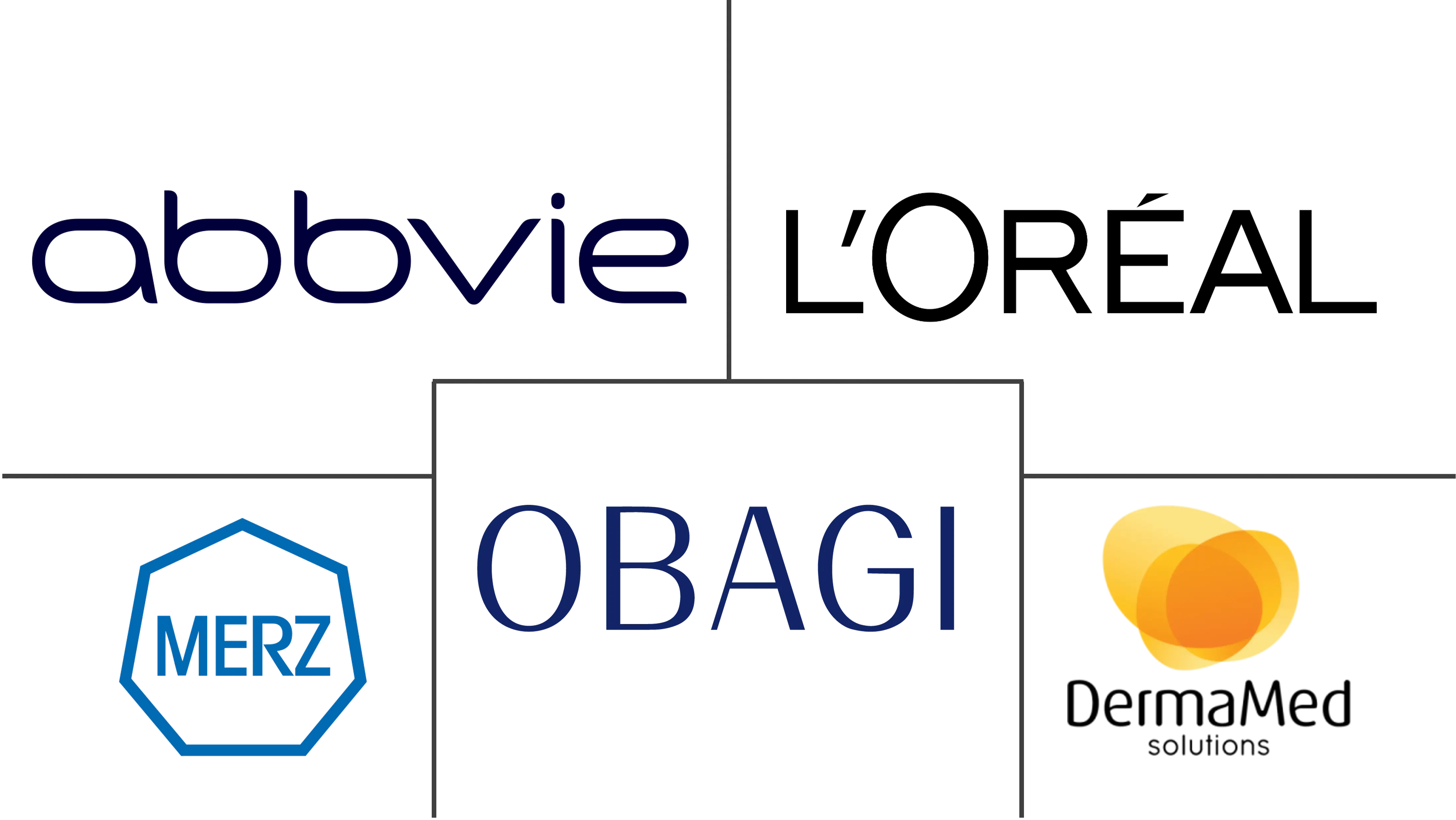Market Size of Pigmentation Disorders Treatment Industry

| Study Period | 2021 - 2029 |
| Market Size (2024) | USD 7.40 Billion |
| Market Size (2029) | USD 9.65 Billion |
| CAGR (2024 - 2029) | 5.43 % |
| Fastest Growing Market | Asia-Pacific |
| Largest Market | North America |
Major Players
*Disclaimer: Major Players sorted in no particular order |
Pigmentation Disorders Treatment Market Analysis
The Pigmentation Disorders Treatment Market size is estimated at USD 7.40 billion in 2024, and is expected to reach USD 9.65 billion by 2029, growing at a CAGR of 5.43% during the forecast period (2024-2029).
COVID-19 had a profound impact on the pigmentation disorders treatment market. According to the Aesthetic Society 2021 report, aesthetic plastic surgery remained popular despite the COVID-19 pandemic. Some countries faced a decline in pigmentation disorders treatment due to the cancellations of non-essential procedures in the country. With the pandemic restrictions lifted, most surgeons are noticing more people seeking cosmetic treatment. With rising strategic initiatives, such as product innovation, launches, and approvals by key players for various pigmentation disorders treatments, the market is expected to regain its traction and witness a stable growth rate over the upcoming years.
The growth of the pigmentation disorders treatment market is attributed to factors such as the increasing prevalence of pigmentation disorders and the growing expenditure on dermatological treatments.
Some examples of common pigmentation disorders include post-inflammatory hyperpigmentation, melasma, solar lentigines, ephelides (freckles), vitiligo, and café au lait macules. Skin biopsy, skin inspection, and a proper dermatologic history can aid in ruling out the melanoma and its antecedents. Pigmentation diseases are treated with topical medicines, chemical peels, cryotherapy, light or laser therapy, or a combination of these techniques to address the underlying illness. For instance, according to a research article published in Karger Journal in 2021, it was observed that people with dark skin (South/Southeast Asian, Hispanic/Latin American, and African descent) have a high prevalence of pigmentary disorders. In addition, as per the same source, pigmentary disorders are the third and fourth most common dermatoses in Blacks and Hispanics. Thus, the high prevalence of pigmentation disorders is expected to create opportunities for market growth in the region where the majority is high to avail treatment options for people, which will further augment the market growth during the forecast period.
Furthermore, increasing company initiatives, such as rising product launches, approvals, and partnerships, drive market growth. For instance, in October 2021, Ahmedabad-based pharma company Uniza Healthcare launched a lotion, Vitellus, to manage Vitiligo in the Indian market. The lotion combines Greyverse, Melitane GL 200, and EUK-134 in collaboration with a Canadian company Lucas Meyer Cosmetics, along with Indian company Amvigor Organics. The partnership among different key players to launch various products indicated for pigmentation disorders is expected to expand the available treatment options for the affected individuals, increase product availability, and thereby propel market growth.
Thus, the market studied is expected to witness significant growth over the forecast period owing to the factors such as the rising prevalence of pigmentation disorders and strategic initiatives undertaken by key players. However, the high cost of cosmetic procedures and inadequate reimbursement policies are expected to hamper the market's growth over the forecast period.
Pigmentation Disorders Treatment Industry Segmentation
Pigmentation disorders comprise many diverse conditions that are usually characterized by altered melanocyte density, melanin concentration, or both, resulting in altered skin pigmentation. Pigmentation disorders are classified into hypopigmentation and hyperpigmentation.
The Pigmentation Disorders Treatment Market is Segmented by Type of Disorder (Albinism, Vitiligo, Melasma, Post-inflammatory Hyperpigmentation (PIH), and Other Types of Disorders), Treatment Type (Topical Treatment, Dermabrasion, Chemical Peels, Laser Treatment, Phototherapy, and Other Treatment Types), and Geography (North America, Europe, Asia-Pacific, Middle East and Africa, and South America). The report also covers the estimated market sizes and trends for 17 different countries across major regions globally. The report offers the value (in USD million) for the above segments.
| By Type of Disorder | |
| Albinism | |
| Vitiligo | |
| Melasma | |
| Post-inflammatory Hyperpigmentation (PIH) | |
| Other Types of Disorders |
| By Treatment Type | |
| Topical Treatment | |
| Dermabrasion | |
| Chemical Peels | |
| Laser Treatment | |
| Phototherapy | |
| Other Treatment Types |
| By Geography | ||||||||
| ||||||||
| ||||||||
| ||||||||
| ||||||||
|
Pigmentation Disorders Treatment Market Size Summary
The pigmentation disorders treatment market is poised for significant growth over the forecast period, driven by the increasing prevalence of pigmentation disorders and heightened expenditure on dermatological treatments. The market is characterized by a diverse range of conditions such as melasma, vitiligo, and post-inflammatory hyperpigmentation, which necessitate various treatment modalities including topical medications, chemical peels, and laser therapies. The market's expansion is further supported by strategic initiatives from key players, including product innovations and collaborations, which aim to enhance the availability and efficacy of treatment options. Despite challenges such as high treatment costs and inadequate reimbursement policies, the market is expected to maintain a stable growth trajectory, with topical treatments holding a substantial share due to their favorable clinical outcomes.
North America is anticipated to dominate the pigmentation disorders treatment market, bolstered by a well-established healthcare infrastructure and a high prevalence of pigmentation disorders such as albinism. The region's market growth is further fueled by robust research and development activities, evidenced by numerous clinical trials aimed at developing new treatments. The competitive landscape of the market is marked by the presence of major players who are actively engaging in partnerships and acquisitions to expand their market presence. These dynamics, coupled with the increasing adoption of cosmetic procedures, are expected to drive the market's growth, making it a vibrant and evolving sector within the healthcare industry.
Pigmentation Disorders Treatment Market Size - Table of Contents
-
1. MARKET DYNAMICS
-
1.1 Market Overview
-
1.2 Market Drivers
-
1.2.1 Increasing Prevalence of Pigmentation Disorders
-
1.2.2 Growing Expenditure on Dermatalogical Treatments
-
-
1.3 Market Restraints
-
1.3.1 High Cost of Cosmetic Procedures
-
1.3.2 Inadequate Reimbursement Policies
-
-
1.4 Industry Attractiveness - Porter's Five Forces Analysis
-
1.4.1 Threat of New Entrants
-
1.4.2 Bargaining Power of Buyers
-
1.4.3 Bargaining Power of Suppliers
-
1.4.4 Threat of Substitute Products
-
1.4.5 Intensity of Competitive Rivalry
-
-
-
2. MARKET SEGMENTATION (Market Size by Value - USD Million)
-
2.1 By Type of Disorder
-
2.1.1 Albinism
-
2.1.2 Vitiligo
-
2.1.3 Melasma
-
2.1.4 Post-inflammatory Hyperpigmentation (PIH)
-
2.1.5 Other Types of Disorders
-
-
2.2 By Treatment Type
-
2.2.1 Topical Treatment
-
2.2.2 Dermabrasion
-
2.2.3 Chemical Peels
-
2.2.4 Laser Treatment
-
2.2.5 Phototherapy
-
2.2.6 Other Treatment Types
-
-
2.3 By Geography
-
2.3.1 North America
-
2.3.1.1 United States
-
2.3.1.2 Canada
-
2.3.1.3 Mexico
-
-
2.3.2 Europe
-
2.3.2.1 Germany
-
2.3.2.2 United Kingdom
-
2.3.2.3 France
-
2.3.2.4 Italy
-
2.3.2.5 Spain
-
2.3.2.6 Rest of Europe
-
-
2.3.3 Asia-Pacific
-
2.3.3.1 China
-
2.3.3.2 Japan
-
2.3.3.3 India
-
2.3.3.4 Australia
-
2.3.3.5 South Korea
-
2.3.3.6 Rest of Asia-Pacific
-
-
2.3.4 Middle East and Africa
-
2.3.4.1 GCC
-
2.3.4.2 South Africa
-
2.3.4.3 Rest of Middle East and Africa
-
-
2.3.5 South America
-
2.3.5.1 Brazil
-
2.3.5.2 Argentina
-
2.3.5.3 Rest of South America
-
-
-
Pigmentation Disorders Treatment Market Size FAQs
How big is the Pigmentation Disorders Treatment Market?
The Pigmentation Disorders Treatment Market size is expected to reach USD 7.40 billion in 2024 and grow at a CAGR of 5.43% to reach USD 9.65 billion by 2029.
What is the current Pigmentation Disorders Treatment Market size?
In 2024, the Pigmentation Disorders Treatment Market size is expected to reach USD 7.40 billion.

